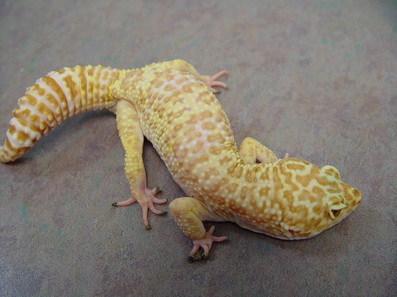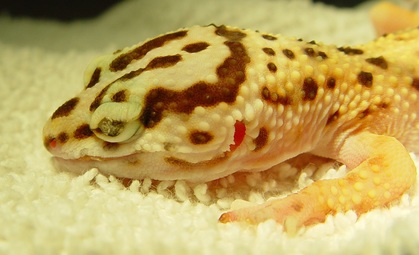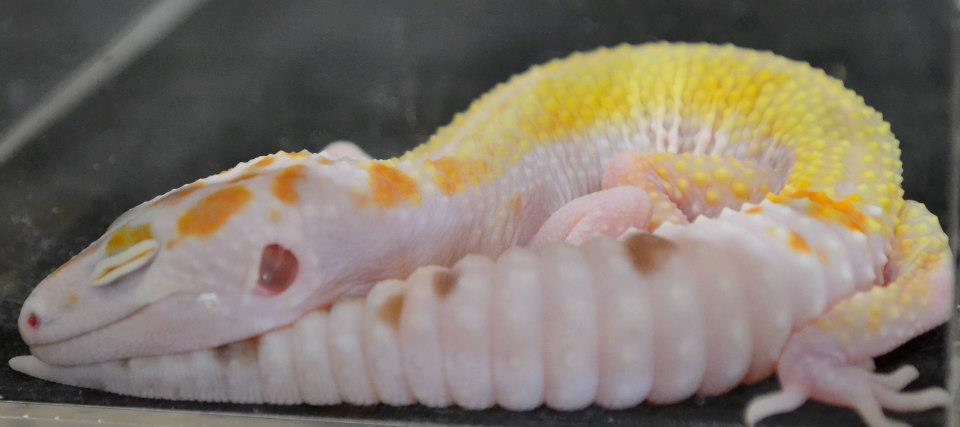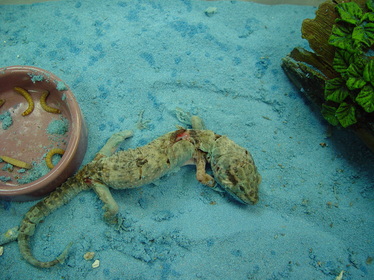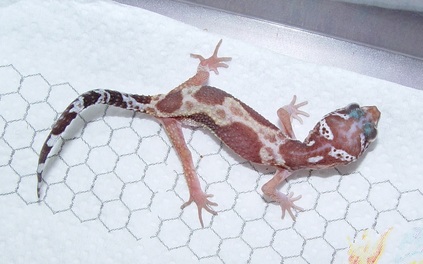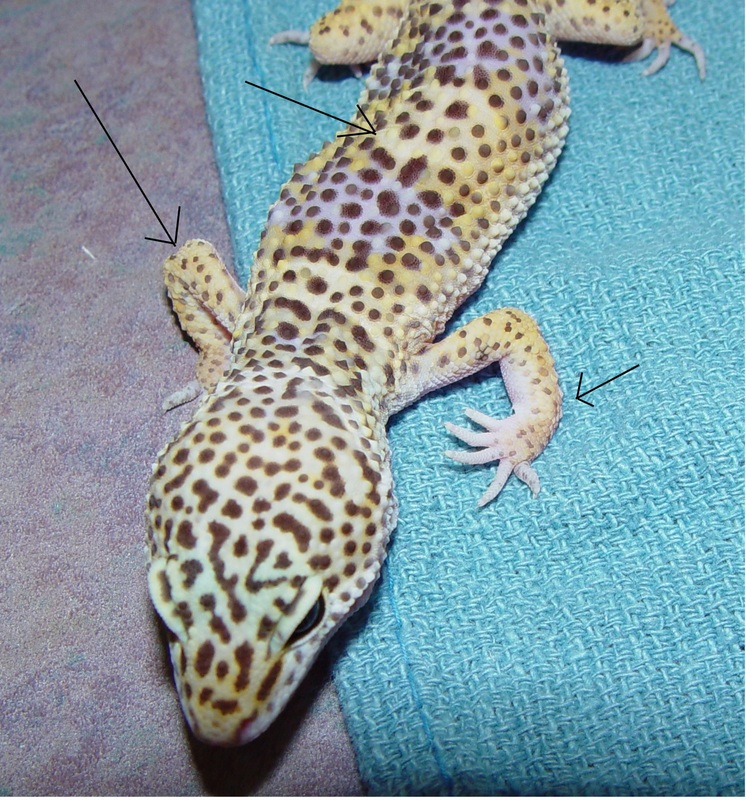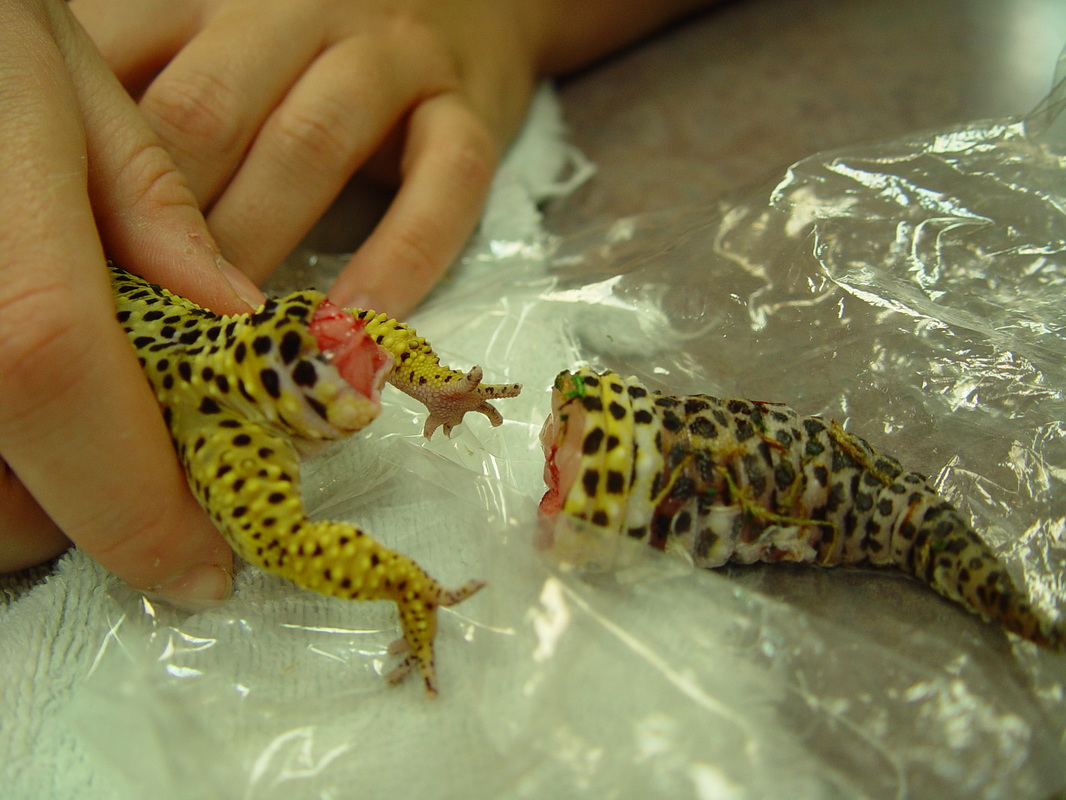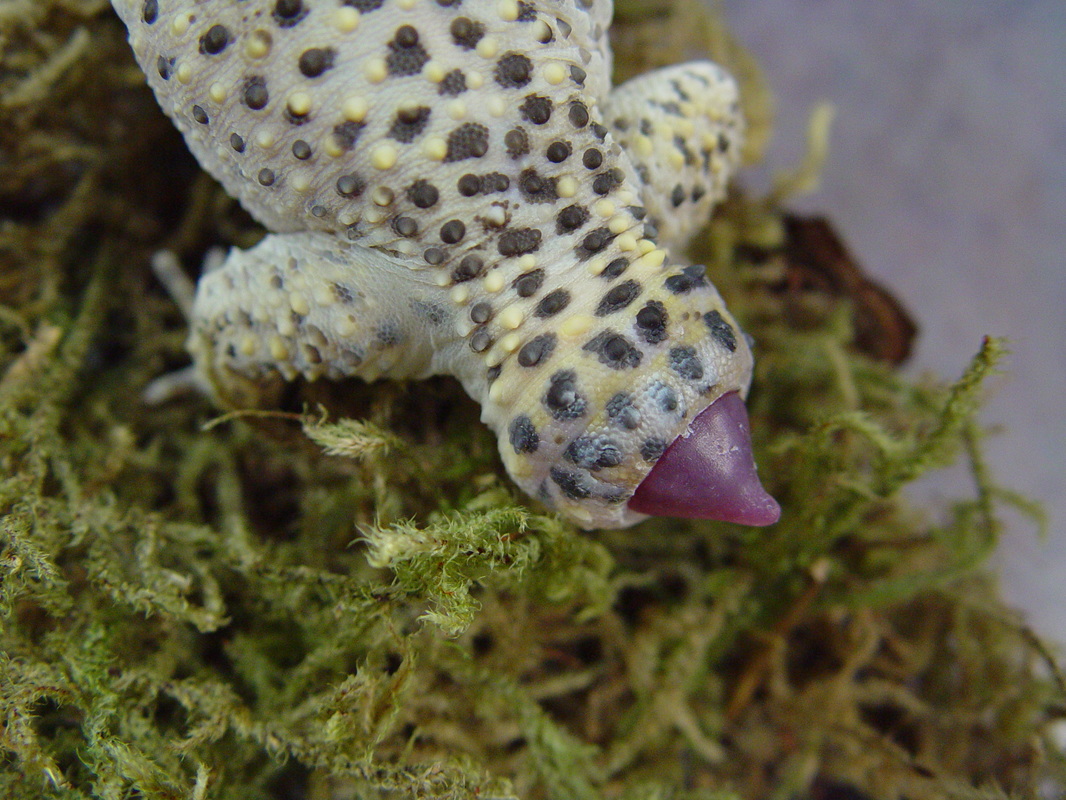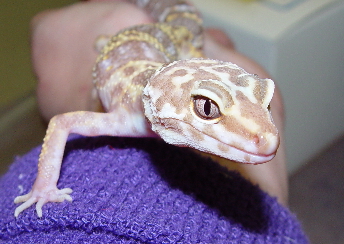Leopard Geckos Care (Eublepharis macularius)
Erica Mede, CVT
Photos by Melissa Borden where noted
Photos/Health by Susan Horton, DVM
Photos by Melissa Borden where noted
Photos/Health by Susan Horton, DVM
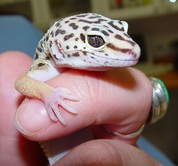
Natural History
Also known as Leos, the Leopard gecko, has become a popular pet in the United States due to their docile temperament and relative ease of care. Native to the southern portion of Asia (mainly Afghanistan, parts of India, parts of Iran, and Pakistan), this crepuscular lizard is commonly found scurrying across the ground. They are active at night or during the twilight hours, but will occasionally bask in sunlight. The rocky, dry grasslands skirting the desert regions are home to this species. Despite a partially desert existence, Leopard geckos do brumate naturally in the wild during the cold season when temperatures hover in the 50’s. Most of the Leopard geckos found in the pet trade are captive bred and even come in fun colors and patterns called "morphs".
Also known as Leos, the Leopard gecko, has become a popular pet in the United States due to their docile temperament and relative ease of care. Native to the southern portion of Asia (mainly Afghanistan, parts of India, parts of Iran, and Pakistan), this crepuscular lizard is commonly found scurrying across the ground. They are active at night or during the twilight hours, but will occasionally bask in sunlight. The rocky, dry grasslands skirting the desert regions are home to this species. Despite a partially desert existence, Leopard geckos do brumate naturally in the wild during the cold season when temperatures hover in the 50’s. Most of the Leopard geckos found in the pet trade are captive bred and even come in fun colors and patterns called "morphs".
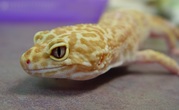
Description
As hatchlings, these lizards measure only 2-3 inches long and reach an adult length of 8-11 inches. Their small stature, visually appealing yellow and white coloration with black spots (normally, although young geckos may be more striped), and life span of 10-20 years makes Leopard geckos an ideal pet for many apartment residents. The skin on the back has a bumpy texture from the nose to the tail tip whereas the abdomen is surprisingly smooth and nearly transparent. This species is capable of autotomy ("tail dropping") when frightened to distract potential predators. "Dropped" tails will grow back although the pattern may not match exactly and it will not have the bumpy texture.
As hatchlings, these lizards measure only 2-3 inches long and reach an adult length of 8-11 inches. Their small stature, visually appealing yellow and white coloration with black spots (normally, although young geckos may be more striped), and life span of 10-20 years makes Leopard geckos an ideal pet for many apartment residents. The skin on the back has a bumpy texture from the nose to the tail tip whereas the abdomen is surprisingly smooth and nearly transparent. This species is capable of autotomy ("tail dropping") when frightened to distract potential predators. "Dropped" tails will grow back although the pattern may not match exactly and it will not have the bumpy texture.
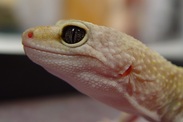
Special Characteristics
Longevity
In captivity, leopard geckos have been known to live over 20 years with proper care. They become sexually mature between 16-24 months, but may not be ready to breed until their third year.
Temperament
Leopard geckos make wonderful pets. The are generally very docile, and can learn to accept handling. They rarely bite, and tend to move slowly once acclimated to their surroundings. They tend to hide during daylight hours.
Anatomy
Leopard geckos have eyelids that can blink. They have toenails, and cannot climb glass.
Longevity
In captivity, leopard geckos have been known to live over 20 years with proper care. They become sexually mature between 16-24 months, but may not be ready to breed until their third year.
Temperament
Leopard geckos make wonderful pets. The are generally very docile, and can learn to accept handling. They rarely bite, and tend to move slowly once acclimated to their surroundings. They tend to hide during daylight hours.
Anatomy
Leopard geckos have eyelids that can blink. They have toenails, and cannot climb glass.
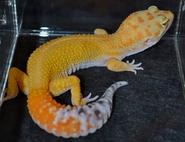 Photo by Melissa Borden
Photo by Melissa Borden
Captive Cage Requirements
Lighting
Ultraviolet B is required to maintain healthy leopard geckos. The best source of UVB is the sun, but special bulbs, (fluorescent such as Reptisun 5.0) can be purchased from a reptile shop. The fluorescent bulb must be placed no more than 12 inches from the basking site, and should be on a timer to provide about 12 hours of daylight and 12 hours of darkness. It must be replaced every 6-9 months, because even though the visible light is emitted, the UVB fades. Light bulbs with a screw –in attachment end (even those sold as “full spectrum” bulbs) provide heat, but not UVB. The exception is the mercury vapor bulb. It emits UVA and UVB radiation and heat. These bulbs are to intense for gecko habitats. There is significant debate over whether Leopard geckos require UVB for maintaining health but it is recommended by Chicago Exotics to help prevent issues with egg laying and prevent secondary nutritional hyperparathyroidism (also known as metabolic bone disease).
Lighting
Ultraviolet B is required to maintain healthy leopard geckos. The best source of UVB is the sun, but special bulbs, (fluorescent such as Reptisun 5.0) can be purchased from a reptile shop. The fluorescent bulb must be placed no more than 12 inches from the basking site, and should be on a timer to provide about 12 hours of daylight and 12 hours of darkness. It must be replaced every 6-9 months, because even though the visible light is emitted, the UVB fades. Light bulbs with a screw –in attachment end (even those sold as “full spectrum” bulbs) provide heat, but not UVB. The exception is the mercury vapor bulb. It emits UVA and UVB radiation and heat. These bulbs are to intense for gecko habitats. There is significant debate over whether Leopard geckos require UVB for maintaining health but it is recommended by Chicago Exotics to help prevent issues with egg laying and prevent secondary nutritional hyperparathyroidism (also known as metabolic bone disease).
Enclosure
Leopard geckos are easily maintained in 15-20 gallon glass aquariums or other enclosures of a similar size. Two geckos can be kept in a 15-gallon enclosure so long as both are female or one is male. Two males will fight and stress each other out. A 20-gallon tank can comfortably house 3 geckos. A ratio of 2 – 3 females to one male is prefered.
Other options for enclosures include sweater box style containers that can be modified for ventilation, heating, and lighting. Some breeders and owners of larger collections will keep their geckos in rack systems that can be purchased or fabricated. Leopard geckos are predominantly terrestrial with a weak climbing ability which should be taken into consideration during enclosure selection.
Leopard geckos are easily maintained in 15-20 gallon glass aquariums or other enclosures of a similar size. Two geckos can be kept in a 15-gallon enclosure so long as both are female or one is male. Two males will fight and stress each other out. A 20-gallon tank can comfortably house 3 geckos. A ratio of 2 – 3 females to one male is prefered.
Other options for enclosures include sweater box style containers that can be modified for ventilation, heating, and lighting. Some breeders and owners of larger collections will keep their geckos in rack systems that can be purchased or fabricated. Leopard geckos are predominantly terrestrial with a weak climbing ability which should be taken into consideration during enclosure selection.
Cage Accessories
A naturalistic terrarium can be created for Leopard geckos using live potted plants such as Sansevierias, grasses, and bromeliads which stay relatively small. Fake plants can be used safely and give the same effect as natural plants. Potted plants should always be herbicide and insecticide free in case of accidental ingestion of the plant or soil by the reptile. Plants are not only aesthetically pleasing to owners but offers enrichment and security for the geckos in the enclosure. It is ideal to supply as much shrubbery and foliage as possible.
Hides in the forms of rocks caves (not heat caves), small cork logs, and other creative hides should be placed in at least two locations in the enclosure. Preferably, one hide area should be provided on the warm end and one on the cooler end to promote thermoregulation with minimal stress on the animal.
Branches, bark, and some small rocks should be added to the enclosure for enrichment and basking purposes. Geckos are naturally found running along rocky terrain with tufts of grass. Leopard geckos are a crepuscular species and will enjoy basking at times.
Water
Provide a water dish that is large enough for the whole gecko to soak its body. Lizards often defecate in their water, so it must be replaced daily and the dish disinfected at least once a week. Periodically, fresh, warm water soaking is recommended to aid in shedding as pictured below. The water should be shallow and never leave your lizard alone while soaking.
A naturalistic terrarium can be created for Leopard geckos using live potted plants such as Sansevierias, grasses, and bromeliads which stay relatively small. Fake plants can be used safely and give the same effect as natural plants. Potted plants should always be herbicide and insecticide free in case of accidental ingestion of the plant or soil by the reptile. Plants are not only aesthetically pleasing to owners but offers enrichment and security for the geckos in the enclosure. It is ideal to supply as much shrubbery and foliage as possible.
Hides in the forms of rocks caves (not heat caves), small cork logs, and other creative hides should be placed in at least two locations in the enclosure. Preferably, one hide area should be provided on the warm end and one on the cooler end to promote thermoregulation with minimal stress on the animal.
Branches, bark, and some small rocks should be added to the enclosure for enrichment and basking purposes. Geckos are naturally found running along rocky terrain with tufts of grass. Leopard geckos are a crepuscular species and will enjoy basking at times.
Water
Provide a water dish that is large enough for the whole gecko to soak its body. Lizards often defecate in their water, so it must be replaced daily and the dish disinfected at least once a week. Periodically, fresh, warm water soaking is recommended to aid in shedding as pictured below. The water should be shallow and never leave your lizard alone while soaking.
Humidity
The humidity in the Leopard gecko enclosure should be kept at 30-40% with a humid hide box offered during shedding to prevent issues. Misting once or twice a day can keep the humidity level and provide necessary hydration along with the water dish. Some may learn to drink from a water dish while others will lick droplets off their skin and enclosure furnishings.
The humidity in the Leopard gecko enclosure should be kept at 30-40% with a humid hide box offered during shedding to prevent issues. Misting once or twice a day can keep the humidity level and provide necessary hydration along with the water dish. Some may learn to drink from a water dish while others will lick droplets off their skin and enclosure furnishings.
|
Pictured above is a Leo who had retained sheds on his toes. The retained sheds cut off circulation to his toe tips causing the toenail beds to die. This is from improper humidity
|
Retained sheds and sand bedding can lead to serious eye problems. Dr. Horton also feels that Vitamin A deficiency also adds to this problem.
|
Temperature
Two thermometers should be utilized to ensure that the proper temperatures are being maintained. The cool end of the enclosure should have the thermometer an inch above the substrate. The thermometer on the warmer end of the enclosure should be at the level of the basking site. A thermostat will also prevent accidental burns as well as provide a stable temperature.
Day time temperatures are typically maintained at 78-85°F with a basking spot of 86-90°F. The basking spot should be situated ideally with a rock over the under tank heater or heat cable and directly underneath the basking light. When using under tank heaters or heat cable to increase the ambient temperature of the enclosure care must be taken that the animal never contacts the heating element itself or the glass/wire/plastic directly over it. A thermostat must be used on all under tank heat sources and a layer of substrate must be provided over the enclosure floor to prevent burns.
At night, the temperatures can drop as low as 70°F but are best maintained between 72 and 75°F. If the ambient temperature in the room the reptile is in drops below 70°F, it is recommended to utilize the under tank heaters, heat cable, or a ceramic heat emitter (which does not give off visible light).
Substrate
Leopard geckos are primarily terrestrial but they do not burrow or dig. The bottom of the enclosure should be covered with something safe and easy to clean. An excellent substrate to use for a gecko enclosure would be indoor/outdoor or reptile carpet or felt which are more aesthetically pleasing than newspaper and easier to clean than paper towel. All are excellent choices for a hygienic cage set-up. Plants can be potted in top soil only to avoid accidental ingestion of toxic materials. If a more naturalistic enclosure is desired, research should be done on the animals true natural environment. This species does not live on loose sand alone. Sand should be avoided to prevent accidental ingestion and life threatening impaction as well as ocular issues. Calcium based sand at the pet stores are not a safe product for Leopard geckos. Since geckos will eat bedding made of small particles, do not use them. Never use sand, wood chips, mulch or gravel. Although many sources claim that sand is a safe substrate, it has been found impacted within the stomach and intestines of leopard geckos after death.
Pictured below is a prime example of why we don't recommend sand. Dehydration, retained sheds, conjunctivitis, sand impaction, all due to this sand. This poor fellow was adopted by one of our technicians and nursed back to health!
Leopard geckos are primarily terrestrial but they do not burrow or dig. The bottom of the enclosure should be covered with something safe and easy to clean. An excellent substrate to use for a gecko enclosure would be indoor/outdoor or reptile carpet or felt which are more aesthetically pleasing than newspaper and easier to clean than paper towel. All are excellent choices for a hygienic cage set-up. Plants can be potted in top soil only to avoid accidental ingestion of toxic materials. If a more naturalistic enclosure is desired, research should be done on the animals true natural environment. This species does not live on loose sand alone. Sand should be avoided to prevent accidental ingestion and life threatening impaction as well as ocular issues. Calcium based sand at the pet stores are not a safe product for Leopard geckos. Since geckos will eat bedding made of small particles, do not use them. Never use sand, wood chips, mulch or gravel. Although many sources claim that sand is a safe substrate, it has been found impacted within the stomach and intestines of leopard geckos after death.
Pictured below is a prime example of why we don't recommend sand. Dehydration, retained sheds, conjunctivitis, sand impaction, all due to this sand. This poor fellow was adopted by one of our technicians and nursed back to health!
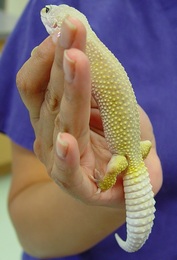 Healthy Leo with a nice chubby tail!
Healthy Leo with a nice chubby tail!
Feeding
The Leopard gecko is a true insectivore enjoying small roaches (such as Dubias), small silk worms, small meal worms, small crickets, and small red worms ("red wrigglers"). A rule of thumb for feeding geckos is the food item offered should always be live and only half the size of the geckos head. Hatchling and young geckos should be offered 2-3 food items once a day and adults should be offered roughly what they can eat in a 10 minute period every other day.
Leopard geckos are entertaining to watch when they feed as they will stalk their prey in the enclosure, swish their tail, then strike very much like a leopard would. Feeder insects should be appropriately gut loaded by offering them dark leafy greens such as kale or endive and carrots (for added vitamin A) 24-48 hours before feeding to the Leo. This method of gut loading helps keep the prey items alive longer. Always remove uneaten food after an hour.
Please, do not leave a dish of calcium powder in their enclosure. This can be dangerous as over doses are possible. If there is a concern that not enough calcium is being offered, a UVB light should be utilized.
The Leopard gecko is a true insectivore enjoying small roaches (such as Dubias), small silk worms, small meal worms, small crickets, and small red worms ("red wrigglers"). A rule of thumb for feeding geckos is the food item offered should always be live and only half the size of the geckos head. Hatchling and young geckos should be offered 2-3 food items once a day and adults should be offered roughly what they can eat in a 10 minute period every other day.
Leopard geckos are entertaining to watch when they feed as they will stalk their prey in the enclosure, swish their tail, then strike very much like a leopard would. Feeder insects should be appropriately gut loaded by offering them dark leafy greens such as kale or endive and carrots (for added vitamin A) 24-48 hours before feeding to the Leo. This method of gut loading helps keep the prey items alive longer. Always remove uneaten food after an hour.
Please, do not leave a dish of calcium powder in their enclosure. This can be dangerous as over doses are possible. If there is a concern that not enough calcium is being offered, a UVB light should be utilized.
Supplements
Juvenile leopard geckos require calcium with D3 supplementation three times a week, and a high quality reptile multivitamin once a week. These should be dusted on insects just before offering to the lizard. Non-breeding adult leopard geckos will do well with weekly calcium and twice monthly multivitamin supplementation.
Grooming and Handling
Although best thought of as display specimens, leopard geckos will learn to tolerate routine handling once they reach 6-8 months of age. When handled regularly, they will begin to move more slowly and will not struggle. Leopard gecko skin is very delicate, so care must be taken to prevent injuring the animal. Finally, because all reptiles all are potentially infected with Salmonella bacteria, which can be transmitted from reptiles to humans, routine cleanliness and hygiene are essential.
Juvenile leopard geckos require calcium with D3 supplementation three times a week, and a high quality reptile multivitamin once a week. These should be dusted on insects just before offering to the lizard. Non-breeding adult leopard geckos will do well with weekly calcium and twice monthly multivitamin supplementation.
Grooming and Handling
Although best thought of as display specimens, leopard geckos will learn to tolerate routine handling once they reach 6-8 months of age. When handled regularly, they will begin to move more slowly and will not struggle. Leopard gecko skin is very delicate, so care must be taken to prevent injuring the animal. Finally, because all reptiles all are potentially infected with Salmonella bacteria, which can be transmitted from reptiles to humans, routine cleanliness and hygiene are essential.
Health
Young leopard geckos can suffer from Secondary nutritional hyperparathyroidism (MBD). They will have rubbery jaws and limbs. This problem is related to improper diet and lighting. Retained toe sheds is also a common problem. This retained skin must be gently removed before it cuts off circulation to the toe tips. Parasites of the intestinal tract can be a big problem. If your gecko has diarrhea, it needs to be checked for internal parasites. Most of these can be treated with medication. The exception is cryptosporidium. Cryptosporidium is a type of protozoan parasite that has become very common in many leopard gecko colonies. There is no effective treatment for it. Geckos usually are found with skinny tails and diarrhea. Occasionally, the may vomit. Never mix new geckos into established colonies until they have been checked out and in quarantine for at least 6 months.
If you have any questions, please feel free to call us at 847-329-8709.
In loving memory of Squishy!
